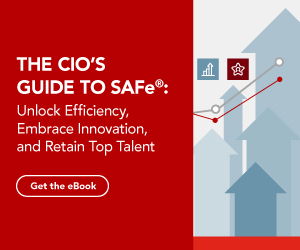
Fortune 500 companies have long recognized the importance of adopting the Scaled Agile Framework® (SAFe®) to stay competitive in today’s fast-paced business landscape. However, despite significant investments integrating SAFe, many organizations struggle to realize the expected return on investment quickly. To address this challenge, IT leaders are seeking innovative ways to tie their digital initiatives to business strategy while reducing costs within SAFe. In response to these demands, the latest updates found in SAFe 6.0 place a stronger emphasis on practicing Value Stream Management (VSM) to manage and optimize flow, alongside using Flow Metrics to measure it.
Our latest guide for CIOs explores how better business outcomes can be achieved by applying Flow Metrics within three key business drivers:
- Business agility in the face of market changes
- Workplace efficiency and productivity, especially in hybrid or remote settings
- Talent acquisition, retention, and development
Below are highlights of some of the valuable insights provided in the guide, which also includes real-life case studies of companies that have applied Flow Metrics and reaped significant rewards.
The Power of Flow to Drive Three Business Outcomes in SAFe
When we think of the word flow, we typically imagine a freely moving body of water or a state of constant motion. In the context of SAFe, flow refers to the smooth and uninterrupted progress of work through the entire value stream, from ideation to delivery.
When flow is optimized by mitigating or removing bottlenecks, organizations can achieve faster and more efficient delivery of products and services to their customers. SAFe recommends adopting VSM and Flow Metrics to measure and optimize flow effectively. While VSM involves identifying, visualizing, and improving the flow of work through the value stream, Flow Metrics provide quantifiable data to measure and analyze flow performance, helping teams make data-driven decisions for process improvement.
1. Increasing Business Agility
One area undergoing rapid evolution in software development is generative AI. Recent advancements in AI technologies have enabled businesses to rapidly generate prototypes, simulations, and designs, significantly reducing traditional development timelines. However, despite these advantages, large enterprises often struggle to match the pace of their digital-native competitors when it comes to getting products to market quickly.
Digital natives possess inherent agility and flexibility in their operations, allowing them to respond to market changes swiftly. In contrast, larger organizations face complexities in their decision-making processes, hierarchical structures, and legacy systems, hindering their ability to adapt at a quick enough pace.
Utilizing Flow Metrics, businesses can gain a deeper understanding of their value streams and identify areas of improvement. In this case, Flow Time can measure the time it takes for work to move through the value stream, pinpointing bottlenecks and inefficiencies. On the other hand, Flow Load® helps organizations assess resource utilization and capacity, enabling them to allocate resources more effectively.
By visualizing Flow Time and Flow Load with tools like Planview Viz, organizations can optimize their workflows and maintain business agility while reducing their time to market.
2. Boosting Workplace Productivity and Efficiency
With the paradigm shift brought on by the COVID-19 pandemic, many organizations have transitioned to fully remote or hybrid work settings. Leaders and teams now face the challenge of ensuring that work aligns with strategic objectives while maintaining visibility into resource utilization.
Economic uncertainty means businesses face the pressing need to unlock capacity with existing resources. However, achieving this goal without overburdening employees and risking burnout is a delicate balancing act.
Flow Metrics, particularly Flow Velocity® and Flow Efficiency®, are vital in addressing these workplace challenges. Flow Velocity will reveal the rate at which work progresses through the value stream, providing insights into productivity. At the same time, Flow Efficiency evaluates how effectively resources are utilized by measuring the proportion of active time over the total elapsed time for a particular flow item (features, defects, risk, and debt).
The two metrics can help organizations identify bottlenecks and improve resource allocation, making work easier to align with strategic objectives while increasing productivity and avoiding employee burnout.
3. Attracting and Retaining Digital Talent
The success of SAFe heavily relies on having employees with the necessary skill sets to excel in agile software delivery. Therefore, it preaches the importance of attracting and retaining top talent by fostering a culture of continuous learning and providing a voice to employees, particularly when addressing technical debt. For this, companies must identify value-adding work to ensure employees’ efforts are not misdirected, which can lead to disengagement.
Optimizing Flow Distribution® is a way to significantly improve work culture and employee engagement. In analyzing Flow Distribution, all work is identified and categorized by type. It is then made visible across the organization, allowing teams to make informed decisions and tradeoffs around planning and executing work. This empowerment encourages employee engagement through collaboration while maintaining the right balance of work, avoiding burnout, and maximizing output.
Leveraging Flow Metrics in SAFe for Enhanced Business Success
The integration of Flow Metrics within the Scaled Agile Framework presents a golden opportunity for companies to achieve better business outcomes. Powerful tools like Planview Viz simplify the measurement and visualization of Flow Metrics, helping organizations enhance business agility, workplace efficiency, and employee engagement. For more comprehensive insights into these business drivers and how they relate to Flow Metrics, along with real-life success stories, download the CIO’s Guide to SAFe® eBook here.




